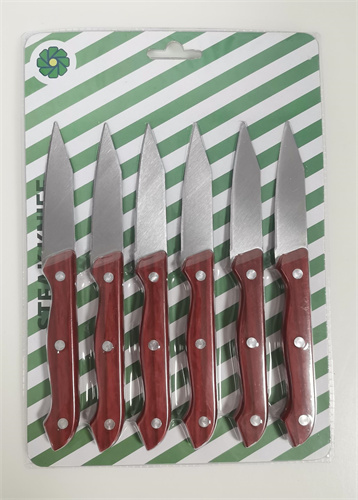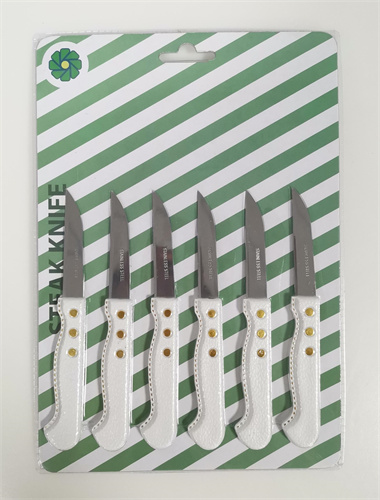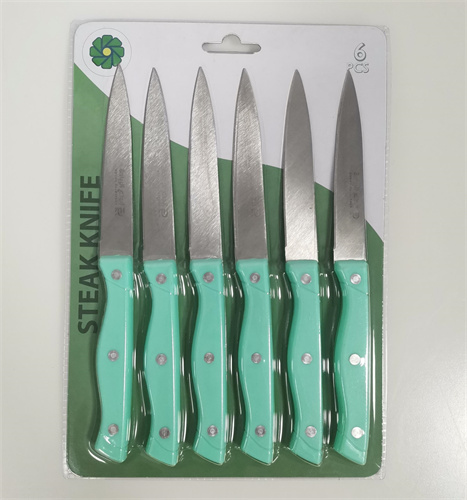

Views: 600 Author: sales@insightknife.com.cn Publish Time: 2025-01-07 Origin: Site








Content Menu
● Best Practices for Storing Steak Knives
>> Knife Blocks
● Frequently Asked Questions regarding Steak Knives
>> 1. How often should I sharpen my steak knives?
>> 2. Can I put my steak knives in the dishwasher?
>> 3. What is the best way to clean steak knives?
>> 4. Is it safe to store steak knives loose in a drawer?
>> 5. What should I do if my steak knife develops rust?
Steak knives are essential tools in any kitchen, designed to enhance the dining experience by providing the perfect cut for meats. However, to maintain their sharpness and longevity, proper storage and care are crucial. This article will explore the best practices for storing and caring for steak knives, ensuring they remain in top condition for years to come.
Steak knives are specialized knives used primarily for cutting cooked meats. They typically feature a serrated edge, which allows for easier slicing through tougher cuts of meat. The design of steak knives can vary, with some having wooden handles while others may feature stainless steel or plastic grips. The choice of material not only affects the knife's aesthetics but also its weight and balance, which can influence the cutting experience. High-quality steak knives are often made from high-carbon stainless steel, which provides excellent edge retention and resistance to corrosion, making them a worthwhile investment for any kitchen.
Proper care of steak knives not only prolongs their lifespan but also ensures safety during use. Dull knives can lead to accidents as they require more force to cut, increasing the risk of slipping and causing injury. Therefore, understanding how to care for and store these knives is essential for any home cook or professional chef. Additionally, well-maintained knives can enhance the overall dining experience, allowing for clean cuts that preserve the texture and flavor of the meat. Investing time in proper care can also save money in the long run, as it reduces the need for frequent replacements.


One of the most effective ways to store steak knives is in a knife block. Knife blocks provide a safe and organized way to keep knives, protecting the blades from damage and preventing them from dulling. When choosing a knife block, consider one that has designated slots for steak knives to ensure they fit securely. A wooden knife block not only offers durability but also adds a touch of elegance to your kitchen countertop. Some knife blocks come with built-in sharpeners, allowing for easy maintenance and ensuring that your knives are always ready for use.
Storing steak knives in a kitchen drawer is another common method. However, it is important to use a knife organizer or a dedicated section within the drawer to prevent the blades from coming into contact with other utensils. This not only protects the knives but also keeps the drawer organized. Drawer inserts made of bamboo or plastic can help keep knives separated and prevent them from sliding around, which can lead to nicks and dulling. Additionally, consider placing a soft cloth or mat at the bottom of the drawer to provide extra cushioning and protection for the blades.
Magnetic strips are an innovative storage solution for steak knives. These strips can be mounted on walls or inside cabinets, allowing for easy access while keeping the knives visible. This method not only saves space but also adds a modern touch to kitchen decor. Ensure that the magnetic strip is strong enough to hold the weight of the knives securely. When using magnetic strips, it is essential to place the knives with the blades facing up to prevent accidental cuts when reaching for them. This storage method also encourages regular cleaning and maintenance, as the knives are more visible and accessible.

For those who prefer to store their steak knives in a drawer without a knife block, using knife sheaths is a great alternative. Knife sheaths protect the blades from damage and prevent accidental cuts when reaching into the drawer. They are available in various materials, including plastic and fabric, and can be a practical solution for knife storage. Some sheaths are designed to fit specific knife sizes, ensuring a snug fit that prevents movement. Additionally, using sheaths can help keep the knives organized and make it easier to find the right one when needed.
It is essential to avoid storing steak knives loose in a drawer without any protection. This can lead to dull blades, nicks, and scratches, which compromise the knife's effectiveness. Additionally, never store knives in a sink or submerged in water, as this can lead to rust and damage to the handles. Proper storage not only protects the knives but also contributes to a safer kitchen environment. By taking the time to store knives correctly, you can prevent accidents and ensure that your tools remain in excellent condition.
Cleaning steak knives after each use is vital to maintain their condition. Hand washing is recommended, as dishwashers can cause damage due to high temperatures and harsh detergents. Use warm, soapy water and a soft sponge to clean the blades, ensuring that no food particles remain. After washing, dry the knives immediately with a soft cloth to prevent water spots and rust. Regular cleaning not only keeps the knives looking good but also prevents the buildup of bacteria, ensuring safe food preparation. For stubborn stains or residues, a gentle scrub with baking soda can help restore the knife's shine without damaging the blade.
Keeping steak knives sharp is crucial for their performance. Regular sharpening helps maintain the blade's edge, making cutting easier and safer. There are several methods for sharpening knives, including using a whetstone, honing rod, or electric sharpener. It is advisable to sharpen knives every few months, depending on usage. For those unfamiliar with sharpening techniques, taking a class or watching instructional videos can be beneficial. Additionally, honing the knife regularly can help maintain the edge between sharpenings, ensuring that the knife remains effective for longer periods.
When using steak knives, always handle them with care. Use a cutting board to protect the blade and the surface you are cutting on. Avoid cutting on hard surfaces like glass or stone, as these can dull the blade quickly. Additionally, always cut away from your body to minimize the risk of injury. Using the right technique not only enhances safety but also improves the efficiency of your cutting. When serving steak, consider using a fork to hold the meat in place, allowing for more controlled and precise cuts.
After using steak knives, ensure they are cleaned and dried before storing them. This prevents moisture from causing rust and keeps the blades in optimal condition. If using a knife block or magnetic strip, place the knives back in their designated spots immediately after cleaning. This habit not only protects the knives but also helps maintain an organized kitchen. Consider creating a routine for knife care, such as cleaning and storing them immediately after each meal, to ensure they are always ready for the next use.
Never soak steak knives in water for extended periods. Prolonged exposure to water can lead to rust, especially if the knives have wooden handles. Instead, clean them promptly after use and dry them thoroughly. If you notice any signs of rust, use a fine steel wool pad to gently scrub the affected area, followed by a thorough cleaning and drying. Taking these precautions will help maintain the integrity of the knives and ensure they remain functional for years to come.
Caring for and storing steak knives properly is essential for maintaining their performance and longevity. By following the best practices outlined in this article, you can ensure that your steak knives remain sharp, safe, and ready for use whenever you need them. Whether you choose to store them in a knife block, drawer, or on a magnetic strip, the key is to protect the blades and handle them with care. With the right approach, your steak knives will serve you well for many delicious meals to come. Investing time in their care not only enhances your cooking experience but also reflects your commitment to quality and safety in the kitchen.

It is recommended to sharpen steak knives every few months, depending on how frequently they are used. Regular honing can help maintain the edge between sharpenings, ensuring optimal performance.
It is not advisable to put steak knives in the dishwasher, as the high temperatures and harsh detergents can damage the blades and handles. Hand washing with warm, soapy water is the best method for cleaning.
The best way to clean steak knives is to wash them by hand using warm, soapy water and a soft sponge. After cleaning, dry them immediately with a soft cloth to prevent rust and water spots.
No, storing steak knives loose in a drawer is not safe. It can lead to dull blades and accidental cuts. Instead, use a knife block, magnetic strip, or knife sheaths to protect the blades and keep them organized.
If your steak knife develops rust, gently scrub the affected area with fine steel wool or a rust eraser. After removing the rust, clean the knife thoroughly with warm, soapy water, and dry it immediately to prevent further rusting.
What Is The Difference between A Carving Knife And A Chef's Knife?
How Often Should I Sharpen My Bread Knife To Maintain Optimal Performance?
How Do Different Blade Shapes Affect The Performance of A Chef's Knife?
What Are The Best Practices for Storing And Caring for Steak Knives?
Are There Specific Types of Steel That Are Better for Steak Knives?